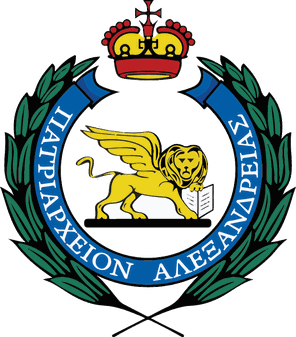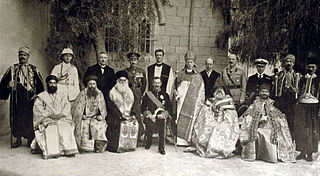In church history, the term acephali has been applied to several sects that supposedly had no leader. E. Cobham Brewer wrote, in Dictionary of Phrase and Fable, that acephalites, "properly means men without a head." Jean Cooper wrote, in Dictionary of Christianity, that it characterizes "various schismatical Christian bodies". Among them were Nestorians who rejected the Council of Ephesus’ condemnation of Patriarch Nestorius of Constantinople, which deposed Nestorius and declared him a heretic.

The Patriarch of Alexandria is the archbishop of Alexandria, Egypt. Historically, this office has included the designation "pope".
Acacius served as the Ecumenical Patriarch of Constantinople from 472 to 489. He was practically the first prelate in all of Eastern Orthodoxy, and was renowned for his ambitious participation in the Chalcedonian controversy.
Jacob Baradaeus, also known as Jacob bar Addai or Jacob bar Theophilus, was the Bishop of Edessa from 543/544 until his death in 578. He is venerated as a saint in the Oriental Orthodox Churches and his feast day is 31 July. Jacob's missionary efforts helped establish the non-Chalcedonian Syriac Orthodox Church, also known as the "Jacobite" Church after its eponymous leader, and ensured its survival despite persecution.
The Patriarch of Antioch is a traditional title held by the bishop of Antioch. As the traditional "overseer" of the first gentile Christian community, the position has been of prime importance in Pauline Christianity from its earliest period. This diocese is one of the few for which the names of its bishops from the apostolic beginnings have been preserved. Today five churches use the title of patriarch of Antioch: one Oriental Orthodox ; three Eastern Catholic ; and one Eastern Orthodox.

Severus the Great of Antioch, also known as Severus of Gaza or the Crown of Syrians, was the Patriarch of Antioch, and head of the Syriac Orthodox Church, from 512 until his death in 538. He is venerated as a saint in the Oriental Orthodox Church, and his feast day is 8 February.
Pope Anastasius of Alexandria, 36th Pope of Alexandria & Patriarch of the See of St. Mark. During his reign, despite being barred from the city of Alexandria, he met with the Patriarch of Antioch as they worked to arrange the unification of their two churches.
Pope Simeon I of Alexandria, 42nd Pope of Alexandria & Patriarch of the See of St. Mark.
Pope Benjamin I of Alexandria, 38th Pope of Alexandria & Patriarch of the See of St. Mark. He is regarded as one of the greatest patriarchs of the Coptic Church. Benjamin guided the Coptic church through a period of turmoil in Egyptian history that included the fall of Egypt to the Sasanian Empire, followed by Egypt's reconquest under the Byzantines, and finally the Arab Islamic Conquest in 642. After the Arab conquest Pope Benjamin, who was in exile, was allowed to return to Alexandria and resume the patriarchate.

The Greek OrthodoxPatriarchate of Alexandria and all Africa, also known as the Greek Orthodox Church of Alexandria, is an autocephalous patriarchate that is part of the Eastern Orthodox Church. Its seat is in Alexandria and it has canonical responsibility for the entire African continent.
The Melitians, sometimes called the Church of the Martyrs, were an early Christian sect in Egypt. They were founded about 306 by Bishop Melitius of Lycopolis and survived as a small group into the eighth century. The point on which they broke with the larger Catholic church was the same as that of the contemporary Donatists in the province of Africa: the ease with which lapsed Christians were received back into communion. The resultant division in the church of Egypt is known as the Melitian schism.
Paul II the Black, also known as Paul of Bēth Ukkāme, was the Patriarch of Antioch and head of the Syriac Orthodox Church from c. 551 or 564 to his deposition in 578. He succeeded Sergius of Tella as the spiritual leader of the Syrian non-Chalcedonians, in opposition to the Chalcedonian Imperial Church, and led the nascent Syriac Orthodox Church as it endured division and persecution.
Peter III of Callinicum was the Patriarch of Antioch and head of the Syriac Orthodox Church from 581 until his death in 591. He is commemorated as a saint by the Syriac Orthodox Church in the Martyrology of Rabban Sliba, and his feast day is 22 April.

The Oriental Orthodox Churches are Eastern Christian churches adhering to Miaphysite Christology, with approximately 60 million members worldwide. The Oriental Orthodox Churches are part of the Nicene Christian tradition, and represent one of its oldest branches.
John Rufus, John of Beth Rufina, or John of Maiuma, was an anti-Chalcedonian priest of Antioch, a disciple of Peter the Iberian and an ecclesiastical historian who possibly served as the bishop of Maiuma. He wrote the Plerophoriae, the Life of Peter the Iberian, and the Commemoration of the Death of Theodosius.
Athanasius I Gammolo was the Patriarch of Antioch and head of the Syriac Orthodox Church from 594/595 or 603 until his death in 631. He is commemorated as a saint by the Syriac Orthodox Church in the Martyrology of Rabban Sliba, and his feast day is 3 January.
The Barsanuphians were a monophysite non-Chalcedonian Christian sect in Egypt between the late 6th and early 9th century.
Athanasius III was the Patriarch of Antioch and head of the Syriac Orthodox Church from 724 until his death in 739/740.

The Holy and Ancient Archdiocese of Jerusalem, All Palestine, and All the Near East or the Coptic Orthodox Patriarchate in Jerusalem, is a Metropolitan Archdiocese of the Coptic Orthodox Church, which is part of the wider communion of the Oriental Orthodox Church. It is headed by the Coptic Orthodox Metropolitan Archbishop of Jerusalem, the incumbent being Metropolitan Archbishop Antonious of Jerusalem since 2016. Its jurisdiction covers those Coptic Orthodox Christians living in the Near East; with churches and monasteries in the State of Palestine, the State of Kuwait, the Hashemite Kingdom of Jordan, the Lebanese Republic, the Syrian Arab Republic, and the Republic of Iraq. The adherents are largely of Coptic Egyptian descent, mainland Coptic migrants and their descendants. The archdiocese is based at St Anthony's Monastery, in the Christian Quarter of the Old City of Jerusalem, beside the Church of the Holy Sepulchre.





